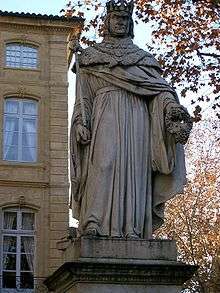La cheminée du roi René
La cheminée du roi René (The Chimney of King René), Op. 205, is a suite in seven movements for wind quintet, composed in 1939 by the French composer Darius Milhaud.

Genesis
The suite is an adaptation of the music that the composer wrote for Raymond Bernard's 1939 film Cavalcade d'amour. It was first performed in 1941 at Mills College, California. The screenplay by Jean Anouilh and Jean Aurenche is set in the court of René I in the fifteenth century and includes three love stories with incidental music by the composers Milhaud, Honegger and Désormière.
When Milhaud finished the piece in 1941, he sent the original score as a gift to a composer he always admired: Charles Koechlin, knowing his passion for the Medieval Music. He got an immediate answer saying: "I didn't accept last year the National Order of the Legion of Honor, but I will accept this wonderful present with great pleasure."
The castle and the court of René I, count of Provence, were situated in Aix-en-Provence, birthplace of Darius Milhaud, who was always fascinated by the history of the king, his code of chivalry and the legendary tournaments that took place at his court. Although the composer studied several musical manuscripts of the period, the writing of La cheminée du roi René shows very little evidence of this; the piece bears the characteristic hallmarks of the rest of Milhaud's music.
Structure
The seven movements of the suite, written for flute, oboe, clarinet, horn and bassoon, have the following titles:
- Cortège (procession)
- Aubade (dawnsong)
- Jongleurs (jugglers)
- La maousinglade (sarabande)
- Joutes sur l'Arc (jousting on the River Arc)
- Chasse à Valabre (hunting at Valabre)[1]
- Madrigal nocturne (nocturnal madrigal)
All the movements are very short, with an alternation between "nonchalant" and very rapid tempi: a collection of medieval miniatures. The shortest movement is less than a minute in length, while the longest is only three minutes long. This gives the impression of a single piece, in just one breath, even more so because the musical atmosphere changes so little between different movements. In all the suite lasts around thirteen minutes.
La maousinglade, a discrete sarabande with the theme taken up by the oboe, is particularly striking. The Joutes sur l'Arc is replete with renaissance ornamentation, while the hunting horn is evoked in the Chasse à Valabre. The final Madrigal, calm, restful and very neoclassical, brings the work to a melancholy close.
La cheminée du roi René is one of Darius Milhaud's best-known works and is one of the most popular pieces of chamber music in the twentieth-century repertoire for wind quintet.[2] The opening motif of Madrigal nocturne, performed by the BBC Concert Orchestra, is used as the signature melody by Sveriges Radio P2 and BBC Radio 3 in their six-hour Through the Night programme.[3]
Notes
- The hunting pavilion of Roy René is a sixteenth-century building in the Domaine de Valabre, Gardanne, a site dating back to the thirteenth century. The Seigneurie of Gardanne was acquired in 1454 by René, who administered it until his death in 1480; apart from establishing the domain as an agricultural center for viticulture, sheep-rearing and olive-growing, he used it as a base for hunting and fishing.
- "Official government classification of Milhaud's music". Retrieved 21 March 2019.
- ""La Cheminée du Roi René" (excerpt from Madrigal-Nocturne) - Darius Milhaud & BBC Concert Orchestra Song - BBC Music". BBC. Retrieved 21 March 2019.
References
- Milhaud, Darius (1953), Notes without Music:An Autobiography, Knopf
- Milhaud, Darius (1998), Ma Vie heureuse, Éditions Aug.Zurfluh, ISBN 2-87750-083-7
- Greenfield, Edward; Layton, Robert; March, Ivan (1988), The New Penguin Stereo Record and Cassette Guide, Penguin Books